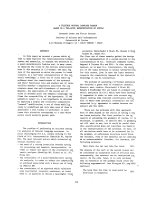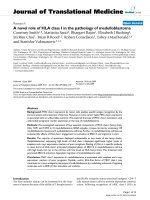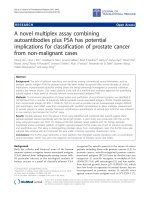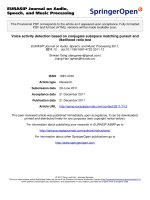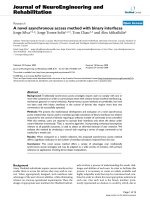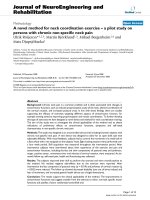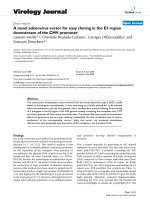Báo cáo toán học: " A novel voice activity detection based on phoneme recognition using statistical model" pdf
Bạn đang xem bản rút gọn của tài liệu. Xem và tải ngay bản đầy đủ của tài liệu tại đây (385.57 KB, 28 trang )
This Provisional PDF corresponds to the article as it appeared upon acceptance. Fully formatted
PDF and full text (HTML) versions will be made available soon.
A novel voice activity detection based on phoneme recognition using statistical
model
EURASIP Journal on Audio, Speech, and Music Processing 2012,
2012:1 doi:10.1186/1687-4722-2012-1
Xulei Bao ()
Jie Zhu ()
ISSN 1687-4722
Article type Research
Submission date 19 September 2011
Acceptance date 9 January 2012
Publication date 9 January 2012
Article URL />This peer-reviewed article was published immediately upon acceptance. It can be downloaded,
printed and distributed freely for any purposes (see copyright notice below).
For information about publishing your research in EURASIP ASMP go to
/>For information about other SpringerOpen publications go to
EURASIP Journal on Audio,
Speech, and Music Processing
© 2012 Bao and Zhu ; licensee Springer.
This is an open access article distributed under the terms of the Creative Commons Attribution License ( />which permits unrestricted use, distribution, and reproduction in any medium, provided the original work is properly cited.
A novel voice activity detection based on phoneme recogni-
tion using statistical model
Xulei Bao
∗
and Jie Zhu
Department of Electronic Engineering, Shanghai Jiao Tong University, Shanghai 200240, China
∗
Corresponding author:
Email address:
JZ:
Email:
∗
Corresponding author
Abstract
In this article, a novel voice activity detection (VAD) approach based on phoneme recognition using Gaussian
Mixture Model based Hidden Markov Model (HMM/GMM) is proposed. Some sophisticated speech features such
as high order statistics (HOS), harmonic structure information and Mel-frequency cepstral coefficients (MFCCs)
are employed to represent each speech/non-speech segment. The main idea of this new method is regarding the
non-speech as a new phoneme corresponding to the conventional phonemes in mandarin, and all of them are then
trained under maximum likelihood principle with Baum–Welch algorithm using GMM/HMM model. The Viterbi
decoding algorithm is finally used for searching the maximum likelihood of the observed signals. The proposed
1
method shows a higher speech/non-speech detection accuracy over a wide range of SNR regimes compared with
some existing VAD methods. We also propose a different method to demonstrate that the conventional speech
enhancement method only with accurate VAD is not effective enough for automatic speech recognition (ASR) at
low SNR regimes.
1 Introduction
Voice activity detection (VAD), which is a scheme to detect the presence of speech in the observed signals
automatically, plays an important role in speech signal processing [1–4]. It is because that high accurate VAD
can reduce bandwidth usage and network traffic in voice over IP (VoIP), and can improve the performance
of speech recognition in noisy systems. For example, there is a growing interest in developing useful systems
for automatic speech recognition (ASR) in different noisy environments [5, 6], and most of these studies are
focused on developing more robust VAD systems in order to compensate for the harmful effect of the noise
on the speech signal.
Plentiful algorithms have been developed to achieve good performance of VAD in real environments in the
last decade. Many of them are based on heuristic rules on several parameters such as linear predictive coding
parameters, energy, formant shape, zero crossing rate, autocorrelation, cepstral features and periodicity
measures [7–12]. For example, Fukuda et al. [11] replaced the traditional Mel-frequency cepstral co efficients
(MFCCs) by the harmonic structure information that made a significant improvement of recognition rate in
ASR system. Li et al. [12] combined the high order statistical (HOS) with the low band to full band energy
ration (LFER) for efficient speech/non-speech segments.
However, the algorithms based on the speech features with heuristic rules have difficulty in coping with
all noises observed in the real world. Recently, the statistical model based VAD approach is considered an
attractive approach for noisy speech. Sohn et al. [13] proposed a robust VAD algorithm based on a statistical
likelihood ratio test (LRT) involving a single observation vector and a Hidden Markov Model (HMM) based
2
hang-over scheme. Later, Cho et al. [14] improved the study in [13] by a smoothed LRT. Gorriz et al. [15]
incorporated contextual information in a multiple observation LRT to overcome the non-stationary noise. In
these studies, the estimation error of signal-to-noise ratio (SNR) seriously affects the accuracy of VAD. With
respect to this problem, the utilization of suitable statistical models, i.e., Gaussian Mixture Model (GMM)
can provide higher accuracy. For example, Fujimoto et al. [16] composed the GMMs of noise and noisy
speech by Log-Add composition that showed excellent detection accuracy. Fukuda et al. [11] used a large
vocabulary with high order GMMs for discriminating the non-speech from speech that made a significant
improvement of recognition rate in ASR system.
To obtain more accurate VAD, these methods always choose a large number of the mixtures of GMM and
select an experimental threshold. But they are not suitable for some cases. To handle these problems, using
the GMM based HMM recognizer for discriminating the non-speech from the speech not only can reduce the
number of mixtures but also can improve the accuracy of VAD without the experimental threshold.
In this article, the non-speech is assumed as an additional phoneme (named as
usp
) corresponding
to the conventional phonemes (such as
zh
,
ang
et al.) in mandarin. Moreover, the speech features,
such as harmonic structure information, HOS, and traditional MFCCs which are combined together to
represent the speech, are involved in the maximum likelihood principle with Baum–Welch (BW) algorithm
in HMM/GMM hybrid model. In the step of discriminating speech from nonspeech, Viterbi algorithm is
employed for searching the maximum likelihood of the observed signals. As a result, our experiments show
a higher detection accuracy compared with the existing VAD methods on the same Microsoft Research Asia
(MSRA) mandarin speech corpus. A different method is also proposed in this article to show that the
conventional noise suppression method is detrimental to the speech quality even giving precise VAD results
at low SNR regimes and may cause serious degradation in ASR system.
The article is organized as follows. In Section 2, we first introduce the novel VAD algorithm. And then,
a different VAD method based on the recursive phoneme recognition and noise suppression methods is given
in Section 3. The detail experiments and simulation results are shown in Section 4. Finally, the discussion
and conclusion are drawn in Section 5 and Section 6 respectively.
3
2 The VAD algorithm
2.1 An overview of the VAD algorithm
As well known, heuristic rules based and statistical model based VAD methods respectively have advantages
and disadvantages against different noises. We combine the advantages of these two methods together for
making the VAD algorithm more robust. The method proposed in this article is shown in Figure 1. We
divide this method into three submodules, such as noise estimation submo dule, feature extraction submodule
and HMM/GMM based classification submodule.
In our study, the MSRA mandarin speech corpus are employed for training the HMM/GMM hybrid
models at different SNR regimes (as SNR=5dB, SNR=10dB et al.) under maximum likelihood principle
with BW algorithm firstly. Then, in the VAD process, the SNR of the noisy speech is estimated by the noise
estimation submodule, and the corresponding SNR level of HMM/GMM hybrid model is selected. After
that, the speech features such as MFCCs, the harmonic structure information and the HOS are extracted
to represent each speech/non-speech segment. Finally, the non-speech segments are distinguished from the
speech segments by the phoneme recognition using the trained HMM/GMM hybrid mo del.
Note that, in this article, the typical noise estimation method named minima controlled recursive aver-
aging (MCRA) is employed for the realization of noise estimation submodule, referring to [17] for details.
2.2 Feature extraction
Different features have their own advantages in ASR system. And it is impossible to use one feature to
cope with all the noisy environments. Combining some features together for discriminating the speech from
non-speech is a popular strategy in recent years. In this article, three useful features such as harmonic struc-
ture information, HOS and MFCCs are combined together to represent the speech signals, since harmonic
structure information is robust to high-pitched sounds, HOS is robust to the Gaussian and Gaussian-like
noise, and MFCCs are the important features in phoneme recognizer.
4
2.2.1 Harmonic structure information
Harmonic structure information is a well known acoustic cue for improving the noise robustness, which has
been introduced in many VAD algorithms [11,18]. In [11], Fukuda et al. only incorporated the GMM model
with harmonic structure information, and made a significant improvement in ASR system. This method
assumes that the harmonic structure of pitch information is only included in the middle range of the cepstral
coefficients. The feature extraction method is shown in Figure 2.
First, the log power sp ectrum y
t
(j) of each frame is converted into the cepstrum p
t
(i) by using the
discrete cosine transform (DCT).
p
t
(i) =
i
M
a
(i, j) ·y
t
(j), (1)
where M
a
(i, j) is the matrix of DCT, and i indicates the bin index of the cepstral coefficients.
Then, the harmonic structure information q
t
is obtained from the observed cesptra p
t
by suppressing the
lower and higher cepstra
q
t
(i) = p
t
(i) D
L
< i < D
H
,
q
t
(i) = λp
t
(i) otherw ise,
(2)
where λ is a small constant.
After the lower and higher cepstra suppressed, the harmonic structure information q
t
(i) is converted back
to linear domain w
t
(j) by inverse DCT (IDCT) and exponential transform. Moreover, the w
t
(j) is integrated
into b
t
(k) by using the K-channel mel-scaled band pass filter.
Finally, the harmonic structure-based mel cepstral coefficients are obtained when b
t
(k) is converted into
the mel-cepstrum c
t
(n) by the DCT matrix M
b
(n, k).
c
t
(n) =
K
k=1
M
b
(n, k) ·b
t
(k), (3)
2.2.2 High order statistic
Generally, the HOS of speech are nonzero and sufficiently distinct from those of the Gaussian noise. Moreover,
it is reported by Nemer et al. [19] that the skewness and kurtosis of the linear predictive coding (LPC) residual
of the steady voiced speech can discriminate the speech from noise more effective.
5
Assume that {x(n)}, n = 0, ±1, ±2, . . . is a real stationary discrete time signal and its moments up to
order k exist, then the kth-order moment function is given as follows:
m
k
(τ
1
, τ
2
. . . τ
k−1
) ≡ E[x(n)x(n + τ
1
) . . . x(n + τ
k−1
)], (4)
where τ
1
, τ
2
, . . . , τ
k−1
= 0, ±1, ±2, . . ., and E[·] represents the statistical expectation. If the signal has zero
mean, then the cumulant sequences of {x(n)} can be defined:
Second-order cumulant
C
2
(τ
1
) = m
2
(τ
1
). (5)
Third-order cumulant
C
3
(τ
1
, τ
2
) = m
3
(τ
1
, τ
2
). (6)
Fourth-order cumulant
C
4
(τ
1
, τ
2
, τ
3
) = m
4
(τ
1
, τ
2
, τ
3
) −m
2
(τ
1
) ·m
2
(τ
2
− τ
3
)
−
m
2
(
τ
2
)
·
m
2
(
τ
3
−
τ
1
)
−
m
2
(
τ
3
)
·
m
2
(
τ
1
−
τ
3
)
.
(7)
Let τ
1
, τ
2
, . . . , τ
k−1
= 0 , then the higher-order statistics such as variance γ
2
, skewness γ
3
, kurtosis γ
4
, can
be expressed as follows respectively:
γ
2
= E[x
2
(n)] = m
2
, (8a)
γ
3
= E[x
3
(n)] = m
3
, (8b)
γ
4
= E[x
4
(n)] −3γ
2
2
= m
4
− 3m
2
2
. (8c)
Moreover, the steady voiced speech can be modeled as a sum of M coherent sine waves, and the skewness
and kurtosis of the LPC residual of the steady voiced speech can be written as functions of the signal energy
E
s
and the number of harmonic M [12]:
γ
3
=
3
2
√
2
(E
s
)
3
2
M − 1
M
, (9)
and
γ
4
= E
s
2
4
3
M − 4 +
7
6M
. (10)
6
2.3 VAD in HMM/GMM model
One of the most widely used method to model speech characteristics is Gaussian function or Gaussian
mixture model. The GMM based VAD algorithm has attracted considerable attention for its high accuracy
in speech/non-speech detection. However, the number of the mixtures of GMMs must be very large to
distinguish the speech from non-speech, which increases the cost of calculation dramatically. Moreover,
N-order GMMs can not discriminate the non-speech from speech precisely since the boundary between the
speech and non-speech is not clear enough. In this article, we improve this method by regarding the non-
speech as an additional phoneme (named as
usp
) corresponding to the conventional phonemes (such as
zh
,
ang
et al.) in mandarin, and using the GMMs based HMM hybrid model to discriminate the non-speech
from speech.
In HMM/GMM based speech recognition [20], it is assumed that the sequence of observed speech vectors
corresponding to each word is generated by a Hidden Markov model as shown in Figure 3. Here, a
ij
and
b(o) means the transition probabilities and output probabilities respectively. 2, 3, 4 are the states of state
sequence X, and O
i
represent the observations of observation sequence O.
As well known, only the observation sequence O is known and the underlying state sequence X is hidden,
so the required likelihood is computed by summing over all possible state sequences X = x(1), x(2), x(3), . . . , x(T ),
that is
P (O|M) =
X
a
x(0)x(1)
T
t=1
b
x(t)
(O
t
)a
x(t)x(t+1)
, (11)
where x(0) is constrained to be the model entry state and x(T + 1) is constraint to be the model exit state.
The output distributions are represented by GMMs in hybrid model as
b
j
(o
t
) =
M
m=1
c
jm
N(o
t
, µ
jm
, Σ
jm
), (12)
where M is the number of mixture components, c
jm
is the weight of mth component and N(o, µ, Σ) is a
multivariate Gaussian with mean vector µ and covariance matrix Σ, that is
N(o, µ, Σ) =
1
(2π)
n
|Σ|
e
−
1
2
(o−µ)
T
Σ
−1
(o−µ)
, (13)
7
where n is the dimensionality of o.
In the GMM/HMM based VAD method, we use the same method which is usually employed in ASR
system by phoneme recognition. In first step, each phoneme (including the conventional phonemes and the
non-speech phoneme) in GMM/HMM hybrid model are initialized. Then the underlying HMM parameters
are re-estimated by Baum-Welch algorithm. In the step of discrimination, Viterbi algorithm is employed for
searching the maximum likelihood of the observed signals, which can be referred to [20] for details. Note
that, in our method, the triphones which are essential for ASR are not adopted here, because we think that
the monophones based recognition is appropriate for discriminating the speech from the nonspeech.
3 A recursive phoneme recognition and speech enhancement method for VAD
It is mentioned that the Minimum Mean Square Error(MMSE) enhancement approach is much more efficient
than other approaches in minimizing both the residual efficient and the speech distortion. Moreover, the
non-stationary music-like residual noise after MMSE processing can be regarded as additive and stationary
noise approximately, which ensures that some simplified model adaption method [14].
Let S
k
(n), N
k
(n), Z
k
(n) denote the kth spectral comp onent of the nth frame of speech, noise and
observed signal, respectively. And assume A
k
(n), D
k
, R
k
(n) are the spectrum amplitude of S
k
(n), N
k
(n),
Z
k
(n). Then the estimate
ˆ
A
k
(n) of A
k
(n) can be given as [14]:
ˆ
A
k
(n) =
1
2
πξ
k
γ
k
(1 + ξ
k
)
M(a; c; x) ·R
k
(n), (14)
where a = −0.5, c = 1, x = −γ
k
ξ
k
/(1 + ξ
k
), and M(a; c; x) is the confluent hypergeometric function. ξ
k
and
γ
k
are interpreted as the a priori and a posteriori SNR, respectively. The estimation of a priori and the a
posteriori can be deemed as follow:
ˆ
ξ
k
(n) = α
ˆ
A
2
k
(n −1)
λ
d
(k, n −1)
+ (1 − α)P
γ
k
(n) −1
, (15)
γ
k
(l) =
|Z
k
(l)|
2
λ
d
(k)
, (16)
8
where the noise variance λ
d
(k) is updated according to the result of VAD.
Generally, we always use the VAD based speech enhancement method for noise suppression before speech
recognition. And it seems that the denoised sp eech is the optimal choice for ASR. If so, we may also can
obtain a more accurate result of change point detection when we use the VAD metho d in the denoised
speech. Following this idea, we propose a different VAD method which integrate our proposed VAD method
(mentioned in Section 2) with the MMSE speech enhancement method, as shown in Figure 4.
The main steps of the proposed method are listed as follows (supp ose the HMM/GMM models have been
constructed).
1 The robust features which are mentioned above are extracted for representing each frame.
2 The change point detection between speech and non-speech is estimated by the phoneme recognition
using the trained HMM/GMM model.
3 The variance of the noise is updated when the non-speech detected, a priori and a posterior of each
frame are then calculated using the Equation (15) and (16).
4 The estimation
ˆ
A
k
(n) is calculated using the Equation (14).
5 Estimate the SNR of the denoised speech to justify whether the SNR is larger than 15dB or not. If the
SNR is less than 15dB, then back to step 1, else the result estimated in step 2 is the final VAD result.
4 Experimental results
In this section, the performances of the proposed method are evaluated. The MSRA mandarin corpus test
data that has 500 utterances with 0.74h length is used as the test set, and the training set from MSRA has
19688 utterances with 31.5h length, referring to [21] for details.
In this article, the feature parameters for the HMM/GMM hybrid model based VAD are extracted at
intervals of 20ms frame length and 10ms frame shift length, composed of 13th order harmonic structure
9
information features, 1st order skewness, 1st order kurtosis, 12th order log-Mel spectra with energy and its
∆, leading to an HMM set with 5 states .
To illustrate the statistical properties of speech signals, we take one of the test utterances as an example,
shown in Figure 5a. As we can see, the proportion of voiced speech to unvoiced speech is almost 3 : 1.
Three different types of experiments are considered here. First, we want to find out whether the increase
of the number of the GMM mixtures can improve the accuracy of VAD. Then, we compare the proposed
VAD method with some existing VAD methods to determine whether the proposed method is more robust
to the noise. And in the last experiment, we use a different method to demonstrate that the conventional
noise suppression method is detrimental to the speech quality even giving precise VAD results at low SNR
regimes.
4.1 Relationship between the VAD accuracy and the number of mixtures
Figure 5b,c depicts the results of VAD by HMM/GMM hybrid model at non-stationary noise environ-
ments. The number of the mixtures of GMM here is 4. The non-stationary noise is downloaded from
http : //www.freesound.org/ named Cars P assing.wav.
From Figure 5b, we can find the proposed VAD method is very robust to the high SNR noise since the
detection of change point is almost completely correct. And the result of the detection accuracy is also
excellent when the SNR is low as shown in Figure 5c.
Less number of the mixtures not only can save the time of discriminating the unvoiced speech from voiced
speech, but also can reduce the memory of storing the GMM parameters. So, with acceptable accuracy of
VAD, the number of the mixtures are the less the better.
In order to investigate the precision of the proposed method in different GMMs mixture number, we take
all the 500 test utterances as examples to obtain the probabilities of accurate VAD detection P
a
at different
kinds of noise with different SNRs.
10
P
a
=
N
i=1
|o(i) −d(i)|/N, (17)
where N is the total number of the corpus frames, o(i) = 0, 1 denotes the labeled speech/non-speech segments,
and d(i) = 0, 1 denotes the estimated speech/non-speech segments.
Figure 6 and Table 1 give the VAD results of the prop osed method from different mixtures of GMMs at
different kinds of noise environments with different SNRs.
In Figure 6, the ylabel denotes the accuracy of VAD, and the xlabel denotes the SNR regimes.
In Table 1, we give another three noise environments as non-stationary noise environments, in-car noise
environment and city street noise environment for test the proposed VAD algorithm, where the noise envi-
ronment is named as N E for short.
Examining Figure 6 and Table 1, we note some interesting points:
• When the noise is Gaussian or Gaussian-like noise, such as gaussian white noise in Figure 6, the
performance of the proposed VAD algorithm is excellent even at low SNR regimes. However, when
meets the non-stationary noise, the algorithm is not robust enough at low SNRs.
• When the number of the mixtures of GMMs increases, the accuracy of the prop osed VAD seems to not
increase by the same rules. As seen from Table 1 and Figure 6, when the SNR is high, the performance
of low order GMMs is better than the performance of the higher order GMMs.
• The VAD algorithm in Gaussian white noise and city street noise have much better performances than
in other noises. This also demonstrates the HOS is robust to the Gaussian/Gaussian-like noise.
• The mix4 has much stable result than any other mixtures in most noisy environments using the
phoneme recognition method based on HMM/GMM hybrid model.
4.2 Comparative analysis of the proposed VAD algorithms
In order to gain a comparative analysis of the proposed VAD performance under different environments such
as the vehicle and street, several classic VAD schemes are also evaluated. The results are summarized in
11
Table 2, where the MOLRT is a method proposed by Lee [22]. The number of the mixtures in the proposed
scheme is 4 according to the result of Table 1.
It is seemed that for all the testing cases, the performance of the proposed VAD is better than that of
the G.729B VAD, the LRT by Sohn and MOLRT by Lee, except for the case of the non-stationary noise
with a SNR of -5dB, where the performance of the proposed VAD is slightly worse than that of the MOLRT
based VAD. In case of the stationary noise, the accuracy of the proposed VAD is higher than 90% in any
SNR level.
4.3 VAD based on the recursive method
In our study, VAD based ASR system is not studied, but we do another experiment to find out whether the
integration of proposed VAD with the conventional speech enhancement can recover the clear speech at low
SNR regimes or not.
We take Figure 5a as the speech prototype, and the VAD results at different noise environments are
shown in Figures 7 and 8. In Figures 7 and 8a, the VAD results are obtained according to the proposed
VAD algorithm, and Figures 7 and 8b show the VAD results based on the integration method.
Examining Figures 7 and 8, we can conclude some interesting points:
• When comparing Figure 7a with Figure 8a, the proposed VAD algorithm is much more robust to the
stationary noise than the non-stationary noise.
• Comparing Figure 7a with Figure 7b, and comparing Figure 8a with Figure 8b, we can find if the
accuracy of the VAD algorithm is very high, the combination method can keep the VAD accuracy, else
the performance will degrade dramatically.
5 Discussion
Some VAD algorithms which have been demonstrated robust to the noise are introduced to the ASR system,
and the performance of the speech recognition seems not bad in high SNR level. For example, Fukuda
12
combines the VAD algorithm with Wiener filter before ASR. However, we think that there are something
more should be done before ASR. So, we first propose a novel VAD algorithm based on HMM/GMM hybrid
model, which is confirmed further by the following experiment to be more robust in many noise environments.
Then we combine the proposed VAD with the speech enhancement algorithm for change point detection to
find out what should be done before ASR.
The novel VAD algorithm proposed in this article is based on the phoneme recognition using HMM/GMM
hybrid model, which is much different from the existing VAD methods. In our study, different GMMs orders
are considered to improve the VAD accuracy, but it seems that the accuracy could not be improved when
the orders become higher.
In order to gain a comparative analysis of the proposed VAD performance under different environments,
several classic VAD schemes are also evaluated. And the results show that the proposed VAD method is
more useful than the existing methods.
We propose a different detection method to indirectly show the reason why the performance of the ASR
system are not well accepted at low SNR regimes, named ’A recursive phoneme recognition and speech
enhancement method for VAD’. And the experimental result is shown in the Section 4.3. Some points are
concluded:
• If the accuracy of the VAD is more than 95%, the noise can be suppressed well with the little speech
distortion. And it is helpful for ASR.
• When the accuracy drops down, the speech can not be recovered well in the noisy speech, despite that
the noise of unvoiced speech can be suppressed. Apparently, the performance of speech recognition
will degrade, and become even worse than the speech recognition without noise suppression.
From Table 1, we have found the accuracy of the VAD is well accepted in most environment at any
SNRs. However, the VAD accuracy can not be improved much when the noise is suppressed by the speech
enhancement method, as shown in Figure 8. It also means the speech enhancement method damage the
speech a lot during the suppression of the noise at low SNRs. If we could keep the quality of the source
13
signal by speech enhancement method, the clear speech can be recovered.
6 Conclusion
In this article, we propose a phoneme recognition based VAD method that follows the idea of phoneme recog-
nition. Note that, the proposed method is much different from others since HMM/GMM based phoneme
recognition is only used for VAD here while others use phoneme recognition for ASR or some other applica-
tions. Some sophisticated features are combined to represent the speech segments. Experiments performed
on MSRA mandarin speech data set confirm the advantage. We compare the proposed algorithm with some
popular VAD methods, and results exhibit the good performance of the proposed algorithm. In the section
of ’VAD based on the recursive method’, we also find more study should be done in the future. First, more
robust VAD algorithm should still be pursued. Second, noise estimation algorithm should be introduced to
the ASR system to forecast the noise component of noisy speech. Third, Some limitations should be set to
reduced the distortion of speech. Last, more robust speech enhancement algorithm is desired.
Competing interests
The authors declare that they have no competing interests.
References
1. JH James, B Chen, L Garrison, Implementing VoIP: a voice transmission performance progress report.
IEEE Commun. Mag. 42(7), 36–41 (2004)
2. C Wang, K Sohraby, R Jana, J Lusheng, M Daneshmand, Voice communications over ZigBee networks.
IEEE Commun. Mag. 46(1), 121–127 (2008)
3. J Chien, C Ting, Factor analyzed subspace modeling and selection. IEEE Trans. Audio, Speech and
Lang. Process. 16(1), 239–248 (2008)
14
4. Y Shao, C Chang, A generalized time-frequency subtraction method for robust speech enhancement
based on wavelet filter banks modeling of human auditory system. IEEE Trans. Systems, Man, and
Cybernetic. 37(4), 877–889 (2007)
5. J Ramirez, JC Segura, JM Gorriz, L Garcia, Improved voice activity detection using contextual multiple
hypothesis testing for robust speech recognition. IEEE Trans. Audio, Speech and Lang. Process. 15(8),
2177–2189 (2007)
6. S Yamamoto, K Nakadai, M Nakano, et al., Real-time robot audition system that recognizes simultaneous
speech in the real world, in Proceedings of the IEEE International Conference on Intelligent Robots and
Systems, 2006, pp. 5333–5338
7. M Fujimoto, K Ihizuka, T Nakatani, A voice activity detection based on the adaptive integration of
multiple speech features and signal decision scheme, in Proceedings of the IEEE International Conference
on Acoustics, Speech and Signal Processing, 2008, pp. 4441–4444
8. G Evanglelopulos, P Maragos, Multiband modulation energy tracking for noisy speech detection. IEEE
Trans. Audio, Speech and Lang. Process. 14(6), 2024–2038 (2006)
9. J Padrell, D Macho, C Nadeu, Robust speech activity detection using LDA applied to FF parameters,
in Proceedings of the IEEE International Conference on Acoustics, Speech, and Signal Processing, vol.
1, 2005, pp. 557–560
10. M Asgari, A Sayadian, M Frahadloo, EA Mehrizi, Voice Activity Detection Using Entropy in Spectrum
Domain, in Telecommunication Networks and Applications Conference, 2008, pp. 407–410
11. T Fukuda, O Ichikawa, M Nishimura, Improved voice activity detection using static harmonic features,
in Proceeding of the IEEE International Conference on Acoustics Speech and Signal Processing, 2010,
pp. 4482–4485
12. K Li, MNS Swamy, OM Ahmad, An improved voice activity detection using higher order statistics.
IEEE Trans. Speech and Audio Process. 13(5), 965–974 (2005)
15
13. J Sohn, NS Kim, W Sung, A statistical model-based voice activity detection. IEEE Signal Process. Lett.
16(1), 1–3(1999)
14. YD Cho, K Al-Naimi, A Kondoz, Improved voice activity detectionbased on a Smoothed statistical
likelihood ratio. in Proceedings of the IEEE International Conference on Acoustics Speech and Signal
Processing, vol. 2, 2001, pp. 737–740
15. JM Gorriz, J Ramirez, EW Lang, CG Puntonet, Jointly Gaussian PDF-Based Likelihood Ratio Test for
Voice Activity Detection. IEEE Trans. On Audio, Speech and Lang. Process. 16(8), 1565–1578 (2008)
16. M Fujimoto, K Ishizuka, H Kato, Noise Robust Voice Activity Detection based on Statistical Model and
Parallel Non-linear Kalman Filtering, in Proceedings ofthe IEEE International Conference on Acoustics
Speech and Signal Processing, vol. 4, 2007, pp. 797–800
17. I Cohen, B Berdugo, Noise estimation based by minima controlled recursive averaging for robust speech
enhancement. IEEE Signal Process. Lett. 9(1), 12–15 (2002)
18. K Ishizuka, T Nakatni, M Fujimoto, N Miyazaki, Noise robust voice activity detection based on periodic
to aperiodic component ratio. Speech Commun. 52(1), 41–60 (2010)
19. E Nemer, R Goubran, S Mahmoud, Robust voice activity detection using higher-order statistics in the
LPC residual domain. IEEE Trans. Speech Audio Process. 9(3), 217–231 (2001)
20. S Young, D Kershaw, J Odell, D Ollason, V Valtchev, P Woodland, The HTK Book. Available from
/>21. HH Xu, J Zhu, GY Wu, An efficient multistage ROVER for automatic speech recognition, in Proceeding
of the IEEE International Conference on Multimedia and Expo, 2009, pp. 894–897
22. LN Tan, BJ Borgstrom, A Alwan, Voice activity detection using harmonic frequency components in
likelihood ratio test, in Proceeding of the IEEE International Conference on Acoustics Speech and Signal
Processing, 2010, pp. 4466–4469
16
Figure 1. An overview of the proposed VAD algorithm.
Figure 2. Harmonic structure feature.
Figure 3. A classical Topology for HMM.
Figure 4. VAD based on the recursive of phoneme recognition and speech enhancement.
Figure 5. An example of the HMM/GMM based VAD with car passing noise. (a) Clean speech,
(b) SNR = 15 dB, (c) SNR = 5 dB.
Figure 6. VAD accuracy by different orders of GMM of different Gaussian noise.
Figure 7. VAD at white noise at SNR = 0 (a) based on the proposed VAD; (b) based on the combined
method.
Figure 8. VAD at non-stationary noise at SNR = 0 (a) based on the proposed VAD; (b) based on
the combined method.
17
Table 1: VAD results from different GMM orders at different kinds of environments with
different SNRs
NE SNR (dB) mix1 (%) mix2 (%) mix4 (%) mix8 (%) mix16 (%)
n-stat −5 77.31 78.90 78.46 83.19 83.17
0 78.22 81.33 82.28 83.40 85.74
5 81.37 82.66 81.65 82.93 84.13
10 85.45 85.97 86.47 88.70 90.66
15 87.91 91.33 92.67 91.91 92.82
20 97.01 96.78 96.49 95.94 95.21
In car −5 94.68 94.80 94.81 94.91 94.94
0 95.70 95.78 95.72 95.70 95.50
5 96.51 96.36 96.52 95.70 95.58
10 96.80 96.57 96.58 96.23 95.84
15 97.49 97.36 97.12 96.53 95.90
20 97.45 97.40 97.16 96.47 95.91
Street −5 88.85 89.21 91.42 94.91 94.94
0 93.84 93.90 94.33 94.49 94.36
5 95.15 95.40 95.24 95.33 95.05
10 96.02 96.32 95.94 95.86 95.46
15 96.68 95.60 97.03 96.38 95.60
20 97.15 97.32 97.27 96.61 95.47
18
Table 2: Comparison results at different kinds of environments with different SNRs
NE SNR (dB) Proposed (%) G.729B (%) Sohn (%) MoLRT (%)
White −5 95.64 71.64 71.71 88.33
0 96.31 72.55 79.75 94.91
10 96.41 73.68 86.17 94.75
20 96.77 74.65 87.58 93.17
Non-stat −5 78.46 70.60 81.74 80.56
0 82.28 70.61 83.08 81.47
10 86.47 70.92 84.15 82.75
20 96.49 71.84 85.23 84.69
In car −5 94.81 71.22 83.78 79.79
0 95.72 72.31 85.03 87.98
10 96.58 74.62 85.98 92.41
20 97.16 75.70 85.78 91.30
Street −5 91.42 76.29 79.95 84.71
0 94.33 76.28 82.32 87.65
10 95.94 75.61 84.39 90.09
20 97.27 75.38 85.59 90.17
19
Feature
extraction
Noise
estimation
VAD based on
Viterbi
GMM of each phoneme
including þuspÿ
Hidden Markov Model
*DXVVLDQ0L[WXUH0RGHO
SNR=5dB
Hidden Markov Model
*DXVVLDQ0L[WXUH0RGHO
SNR=10dB
Hidden Markov Model
Gaussian Mixture Model
SNR=15dB
Noisy
Speech
Figure 1
Log power
spectrum
DCT
Obtain harmonic
information
IDCT
Convert to linear
domain
Mel filter bank
process
DCT
Noisy speech
coe
Figure 2
2
a
12
a
22
a
23
a
33
D
34
a
44
a
45
b( )
o
2
b
3
( )
o
b
4
( )
o
O
1
O
2
O
3
O
4
5
O
t
Figure 3
Features extraction
Proposed VAD
STSA MMSE
SNR acceptable?
Features extraction
VAD result
Noisy speech
<
1
Figure 4
Fig.5 An example of the HMM/GMM based VAD with car passing noise. (a) Clean speech, (b)
Figure 5


